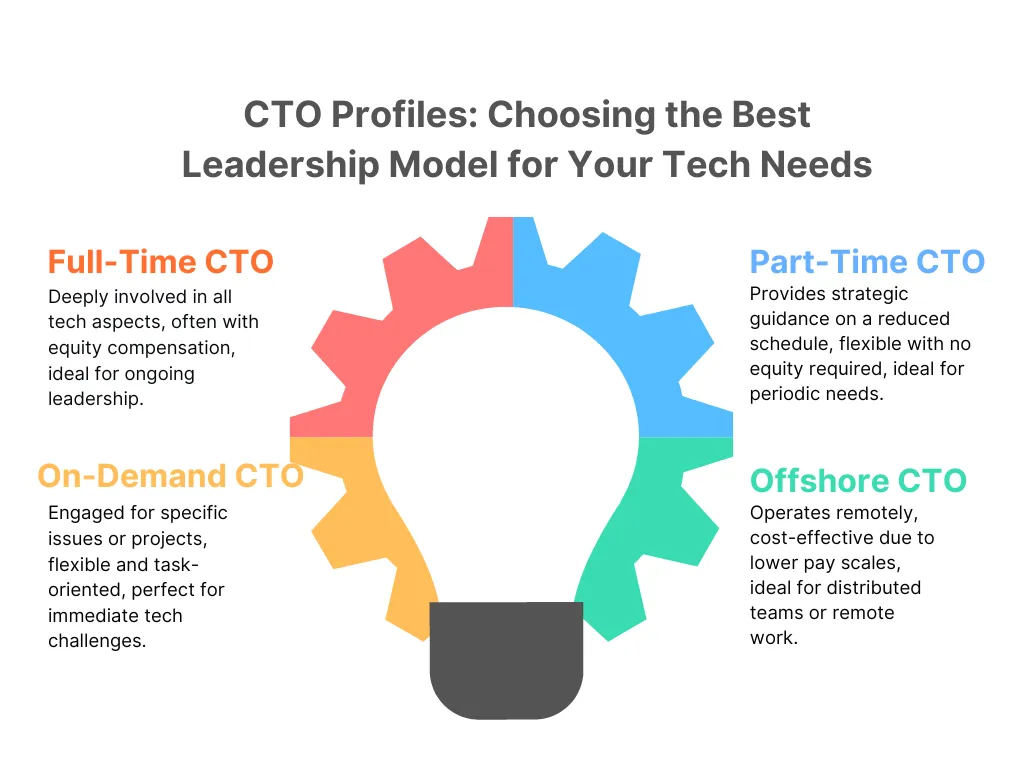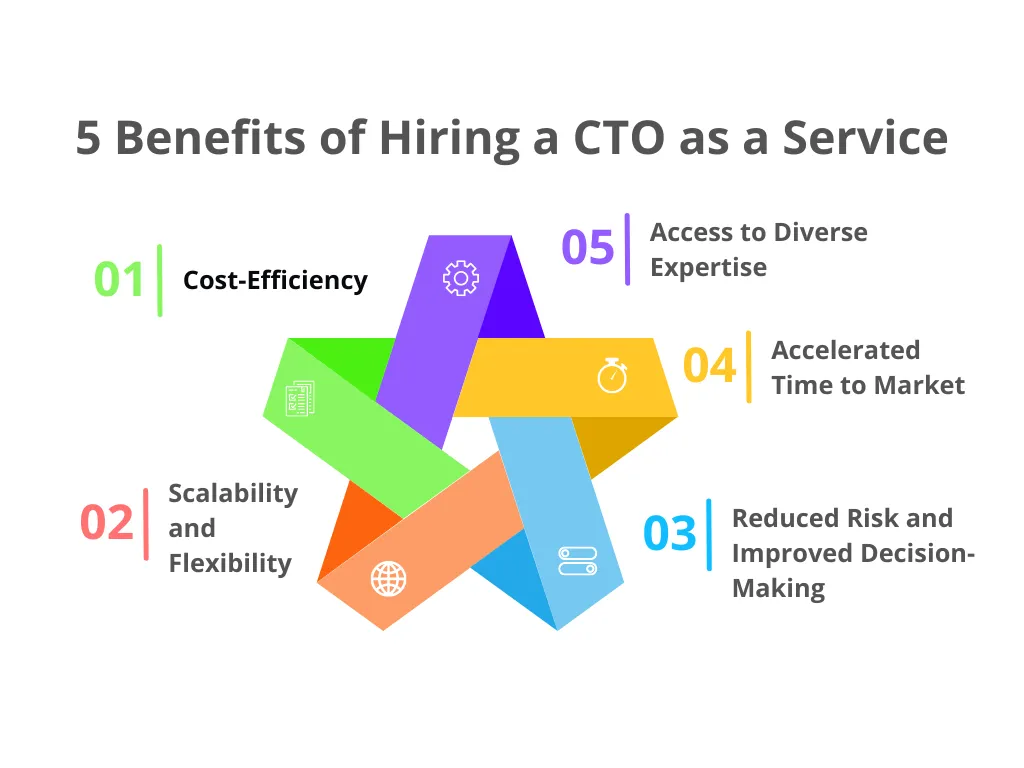A Chief Technology Officer (CTO) plays a vital role in defining and executing a company’s technology strategy. However, for startups and growing businesses, hiring a full-time CTO can be a challenge due to high costs and limited access to experienced tech leaders. CTO as a Service (CTOaaS) offers a flexible and cost-effective solution, allowing businesses to access the expertise of seasoned CTOs without the overhead of a full-time hire. This guide covers everything you need to know about CTOaaS, including its benefits, responsibilities, and tips on choosing the right service for your business.
Key Takeaways
- CTOaaS provides on-demand access to experienced tech leaders, making it ideal for startups and growing businesses.
- It offers strategic guidance, product development oversight, and technology management tailored to your needs.
- Choosing the right CTOaaS involves assessing expertise, communication skills, and cultural fit with your team.
What is CTO as a Service?
CTO as a Service (CTOaaS) is a flexible, on-demand solution that provides businesses with access to an experienced Chief Technology Officer without the long-term commitment or high costs of a full-time hire. CTOaaS providers offer expert guidance in technology strategy, product development, digital transformation, and team management, tailored to the unique needs of your business.
CTOaaS can be particularly beneficial for startups, small businesses, or companies undergoing rapid growth and needing expert leadership to navigate complex technological challenges. By leveraging CTOaaS, businesses can access seasoned tech leaders who can drive innovation, manage development teams, and align technology efforts with business objectives.
Types of CTOs

When selecting a CTO, it’s essential to understand the different types available and what each brings to the table. Each type of CTO has specific roles, commitment levels, and benefits, making them suitable for different business scenarios. Here’s a closer look at the various types:
1. Full-Time CTO
Role and Commitment: A full-time CTO plays the role of a technical co-founder and is deeply involved in every aspect of a company’s technology strategy. This CTO is an integral part of the executive team, often sharing in the company’s success through equity.
Equity Sharing: Full-time CTOs frequently take on a co-founder role in startups, making them more invested in the company’s long-term success. This arrangement often involves equity compensation, aligning their interests with the company’s growth and goals.
Responsibilities: They are responsible for setting the overall tech vision, managing tech teams, overseeing product development, and ensuring that the company’s technology strategy aligns with its business objectives.
Best Suited For: Established companies or startups with significant funding who need continuous, in-depth tech leadership. They are ideal for businesses that require ongoing product innovation, rapid scaling, and dedicated leadership.
2. Part-Time CTO
Role and Commitment: A part-time CTO is engaged on a reduced schedule, usually working a set number of hours per week or month. They provide the same level of strategic guidance as a full-time CTO but without the same level of day-to-day involvement.
No Equity Required: Unlike full-time CTOs, part-time CTOs typically do not require equity. They are paid on a contract or consulting basis, offering flexibility for businesses that need expert advice without long-term financial commitments.
Responsibilities: They provide strategic technology guidance, oversee specific projects, and help establish best practices. Part-time CTOs are perfect for periodic needs like tech audits, strategy sessions, or occasional team mentorship.
Best Suited For: Small to medium-sized businesses or startups that require high-level guidance but do not have the budget or need for a full-time tech leader. It’s also ideal for companies in transitional phases or those needing temporary CTO support.
3. On-Demand CTO
Role and Commitment: On-demand CTOs are brought in specifically to address pressing issues, strategic challenges, or critical projects. Their engagement is highly flexible and task-oriented, often working on a short-term basis to resolve specific technical problems.
Project-Based Engagement: On-demand CTOs work on an as-needed basis, making them highly adaptable to a company’s immediate needs. They might be hired to lead a particular project, troubleshoot a technical problem, or provide guidance during a pivotal product launch.
Responsibilities: They offer expert solutions to immediate problems, provide strategic advice for new technology initiatives, and ensure that the technology infrastructure aligns with the company’s short-term goals.
Best Suited For: Startups and growing companies facing specific tech challenges, product launches, or technology pivots. Businesses that need expert intervention without a long-term commitment find on-demand CTOs particularly valuable.
4. Offshore CTO
Role and Commitment: Offshore CTOs can belong to any of the above categories—full-time, part-time, or on-demand—but they operate from overseas locations. This allows companies to access experienced tech leadership at significantly lower costs due to geographical differences in pay scales.
Cost-Effectiveness: Offshore CTOs offer a budget-friendly alternative to onshore CTOs. The lower cost of living in many offshore locations enables companies to get high-quality expertise at reduced rates, often without sacrificing skills or experience.
Responsibilities: They provide the same level of strategic oversight and leadership as their onshore counterparts but do so remotely. This setup can involve managing development teams in their home countries or integrating with the company’s local teams through virtual collaboration tools.
Challenges and Considerations: While cost-effective, offshore CTOs may face challenges such as time zone differences, language barriers, and cultural nuances that need careful management to ensure seamless collaboration.
Best Suited For: Companies looking to optimize costs without compromising on technology leadership. Offshore CTOs are ideal for businesses with distributed teams, remote-first cultures, or those comfortable managing international workflows.
When Do You Need CTO-as-a-Service?
Understanding when your business requires CTOaaS is crucial for making the right decision. Here are common scenarios when CTOaaS becomes valuable:
- Early-Stage Startups: When you’re in the early stages of your business, every decision matters. CTOaaS provides critical guidance on technology stack choices, development practices, and scalability, all without the financial burden of a full-time CTO.
- Rapid Scaling: As your business begins to grow, scaling technology becomes a complex challenge. A CTOaaS can help navigate this growth, ensuring that your tech infrastructure scales efficiently and your product development processes remain robust.
- Technology Pivot or Transformation: When you need to pivot your technology strategy—whether due to market shifts, evolving customer needs, or internal changes—a CTOaaS brings the necessary expertise to guide you through the transformation.
- Project-Specific Needs: Whether it’s developing a new product, integrating AI into your existing systems, or implementing cybersecurity measures, a project-based CTOaaS provides the focused expertise you need to execute with precision.
- Lack of In-House Expertise: Small teams often lack the diverse skill set needed to address complex tech challenges. CTOaaS offers access to a wide range of skills, from strategic planning to operational management, filling gaps in your current team.
CTO’s Roles and Responsibilities
A CTO as a Service brings a wealth of expertise and a diverse set of responsibilities that can greatly influence your business’s success. Here are the key roles they fulfill:
- Developing Technology Strategy: The CTO’s primary responsibility is to develop a technology strategy that aligns with your overall business goals. This involves understanding your market, competitors, and technological landscape to create a roadmap that supports growth.
- Product Development Oversight: CTOaaS ensures that your product development process is streamlined, efficient, and aligned with market demands. They guide teams through the development cycle, from ideation to launch, ensuring that products meet quality and performance standards.
- Digital Transformation Leadership: CTOaaS plays a crucial role in driving digital transformation initiatives, such as moving to the cloud, adopting AI and machine learning, or automating key business processes. They ensure that technology investments are aligned with business outcomes.
- Team Management and Mentorship: A key role of a CTO is to manage and mentor the technical team, fostering a culture of innovation and continuous improvement. They help build the right skills within the team, manage talent, and ensure effective collaboration.
- Security and Compliance Oversight: With cybersecurity threats on the rise, CTOaaS ensures that your technology stack is secure and compliant with industry regulations. They implement best practices in security, data privacy, and compliance to protect your business from risks.
- Vendor Management and Technology Partnerships: Managing third-party vendors is a critical responsibility of a CTO. CTOaaS handles vendor negotiations, monitors service levels, and ensures that third-party solutions integrate smoothly into your existing systems.
- Budget Management: CTOaaS is often responsible for managing the technology budget, ensuring that spending aligns with strategic priorities. They work closely with finance teams to forecast costs, justify technology investments, and optimize spending.
5 Benefits of Hiring a CTO as a Service

- Cost-Efficiency: Hiring a full-time CTO can be costly, especially for smaller businesses. CTOaaS allows you to access top-tier expertise without the significant salary, benefits, and overhead costs associated with a permanent hire.
- Scalability and Flexibility: CTOaaS provides the flexibility to scale services up or down based on your needs. Whether you require full-time engagement during a critical project or part-time oversight for ongoing support, CTOaaS can be tailored to your requirements.
- Access to Diverse Expertise: CTOaaS providers bring a breadth of experience across industries and technologies, offering insights that may not be available from a single full-time hire. This diversity allows your business to benefit from best practices and innovative approaches.
- Accelerated Time to Market: With a seasoned CTO guiding your technology strategy, your business can accelerate product development timelines, reduce roadblocks, and bring solutions to market faster, enhancing your competitive edge.
- Reduced Risk and Improved Decision-Making: CTOaaS provides a strategic partner who can identify potential risks, guide technology decisions, and help you avoid common pitfalls. Their expertise reduces the risk of costly mistakes and ensures that technology investments drive business value.
3 Mistakes to Avoid When Opting for a CTO as a Service
- Choosing Based on Cost Alone: While cost is an important factor, selecting a CTOaaS provider solely based on price can lead to poor outcomes. Ensure that the provider has a proven track record, industry expertise, and a strategic vision aligned with your business.
- Lack of Clear Expectations and KPIs: Failing to set clear expectations and key performance indicators (KPIs) can lead to misalignment and confusion. Define roles, responsibilities, and success metrics upfront to ensure that your CTOaaS engagement delivers the desired outcomes.
- Ignoring Cultural Fit: A CTO must integrate seamlessly with your existing team, aligning with your company’s culture and values. Assess the provider’s communication style, approach to leadership, and ability to work within your organizational environment.
How to Find the Perfect CTO as a Service: 3 Methods
- Leverage Your Network: Tap into your professional connections to get referrals for trusted CTOaaS providers. Recommendations from peers who’ve had successful engagements can guide you toward reliable options.
- Use Professional Platforms: Explore platforms like LinkedIn, Clutch, and Upwork to find and review profiles of CTOaaS providers. Look for client reviews, case studies, and past experiences relevant to your needs.
- Conduct a Trial Engagement: Start with a small project or limited engagement to assess the provider’s expertise, approach, and compatibility with your team before committing to a full partnership.
What to Look for if You’re Choosing a CTO as a Service
- Relevant Industry Experience: Ensure the CTOaaS provider has experience in your sector to bring valuable insights and tailored solutions.
- Strong Communication Skills: Choose a provider who can clearly explain technical concepts to both tech and non-tech stakeholders, ensuring everyone is aligned.
- Cultural Fit: Select a CTOaaS that matches your company’s values, pace, and work style to foster a smooth working relationship.
- Proven Track Record: Look for evidence of past successes, such as case studies or client testimonials, to verify the provider’s capabilities.
At Bluetick Consultants, we offer:
- Strategic Technology Planning: Aligning tech strategy with business goals.
- Product Development Leadership: Guiding products from concept to launch.
- Team Mentorship: Empowering your tech teams with skills and guidance.
- Digital Transformation: Modernizing your tech stack and processes.
- Flexible Engagement Models: Options including Interim, Fractional, and Project-Based CTOs.
Conclusion
Choosing the right CTOaaS brings expert tech leadership tailored to your business, without the cost of a full-time hire. Focus on experience, communication, cultural fit, and proven success when selecting a provider. Bluetick Consultants’ CTOaaS can help drive your tech strategy forward with confidence.
Ready to take the next step? Contact us to learn more about how our CTO as a Service can support your growth.
